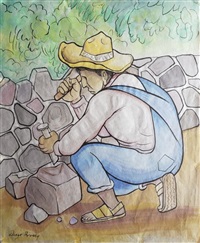Diego Rivera
(Mexican, 1886–1957)
Biography
Diego Rivera was one of Mexico’s most acclaimed painters whose large fresco works helped bring about the Mexican Muralist movement alongside José Clemente Orozco and David Alfaro Siquerios. A committed Communist, much of Rivera’s imagery was based on his political views, as seen in his Detroit Industry Murals (1933). Rivera often depicted workers and their toil rather than the wealthy industrialists who were his patrons. The artist’s political convictions led to an infamous confrontation with Nelson D. Rockefeller, who commissioned Rivera to make a mural about progress. After its completion Rockefeller had the finished work chiseled off the wall because it included an image of Vladimir Lenin. “All painters have been propagandists or else they have not been painters,” he once proclaimed. “Every artist who has been worth anything in art has been such a propagandist. I want to be a propagandist and I want to be nothing else. I want to use my art as a weapon.” Born on December 8, 1886 in Guanajuato, Mexico he studied at the San Carlos Academy of Fine Arts. In 1902, he was expelled from the institution for leading a student protest, and subsequently embarked on travels throughout Mexico and abroad. He eventually made his way to Madrid, briefly working under the artist Eduardo Chicharro Aguera. Rivera moved to Paris in 1909 where he was deeply influenced by Pablo Picasso’s Cubist works. The artist was married four times, most famously to fellow Mexican painter Frida Kahlo. Though the couple divorced in 1939, they remarried a year later and remained together until Kahlo’s death. Rivera died on November 24, 1957 in Mexico City, Mexico. Today, his works are held in the collections of the Art Institute of Chicago, The Museum of Modern Art in New York, the Museo Diego Rivera in Mexico City, and the Peggy Guggenheim Collection in Venice, among others.


.jpg)












.jpg)








